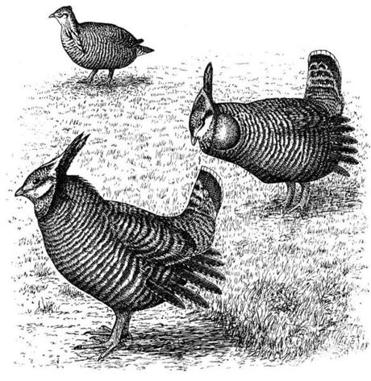All the biologists out there know about the heath hen: it’s probably the number one most common example of a recent extinction discussed in considerable detail, because it illustrates so well that extinction is a product of so many factors, from habitat loss to inbreeding to predation to competition to climate shifts to you name it. The last bird died in 1932.
But now, something amazing has been unearthed: a 40-minute movie of the heath hens in their final reserve on Martha’s Vineyard, made in 1918. There’s a two-minute clip at the link. Watch the last dance of the heath hen and feel the loss.



As i saw both the painting and the video i was thinking “whaaat? this is not extinct, i´ve seen it in documentaries O_o”…i had to look it up to discover that this was a specific subspecies that disappeared many decades ago.
With that i don´t want to imply that hey, it´s just a subspecies, we haven´t lost the species or anything…far from it, to anyone who would think that way i´d like to underline that we usually focus on the species level rather than value every type of diversity and that´s a mistake.
If you want to see that dance nowadays pop along to a lek of the Scottish grouse – must be a very close relative.
Or, come out to prairies in western Minnesota (Bluestem Prairie for example) and watch 20+ males Greater prairie-chicken displaying at once.
There are many speies with wide ranges in central North America which have (or had) subspecies in northeastern North America. The Sandhills cutworm, Euxoa detersa detera and the Melissa blue butterfly Plebejus melissa samuelis are two examples.
well, but when either species o subspecies go extinct, they do permanently
except if their DNA is available…
Even when the DNA is available, the (sub)species still go extinct. Perhaps at some point we will resurrect a living display specimen or two, but the species will still be extinct.
The new Sibly bird guide (despite some printing faults) quite rightly illustrates extinct North American birds with the date of their last being found in the wild, rather than the date from the lingering on of single zoo specimens. Species are made up of populations.
Attwater’s prairie chickens in Texas are extremely close to extinction–probably the closest sub species, as it’s also a coastal bird. It’s actually NOT TOO LATE to do something here, with as much support as they can get.
The very first thought in my early AM, pre-coffee mind upon seeing those birds was, “Oh! Chicken rabbit!”
Cousin to the crocoduck.
Oh wow. I’ve never even heard of these birds!
My first thought on seeing the film was “It looks like a grouse. I wonder if they’re related?”, but on reading the gumpf I see it’s a subspecies of Prairie Chicken. Wikipedia has revealed that they are indeed a member of the same sub-family as the grouse, the Tetraoninae.
Wikipedia also reveals that the Heath Hen may well have been a separate species rather than a sub-species, though this appears to have been an issue of some debate before the birds kindly solved the problem by dying out; and that the Greater Prairie Chicken is now considered “vulnerable”.
…I had no idea. I’ve never heard of… any American tetraonines, really.
David Quammen’s book, “The Song of the Dodo: Island Biogeography in an Age of Extinctions ” has some age on it now, but has an excellent section on the heath hen extinction.
I can do nothing but weep.
I saw a portion of this old film two weeks ago at the Massachusetts Audubon Society’s annual Birder’s Meeting. It gave me an eerie and sad feeling. The theme of the day is “Extinction Is Forever.” Not the most cheery theme, but important lessons can be drawn from humanity’s treatment of the great auk, the dodo, and the passenger pigeon. Dr. Joel Greenberg gave a talk on the latter and screen the beta version of his documentary Project Passenger Pigeon. Tell your local PBS station that you want them to screen this documentary!
The big takeaway from all the extinction talks: protect species *before* they become threatened or endangered. That’s tougher now than in the 1800s because land is exponentially more expensive and because private interests see threatened animals as economic loss. In CA business groups are fighting the listing of a type of grouse on the Endangered Species List. If its habitat is protected, that land can’t be exploited by humans for resources.